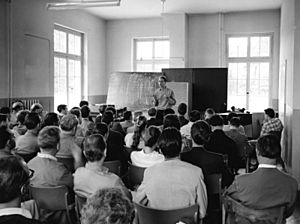Aleatoric music facts for kids

Aleatoric music (also called chance music) is a type of music where some parts of the song are left up to chance. The word "aleatoric" comes from the Latin word alea, which means "dice". This means that instead of the composer deciding every single note or rhythm, some parts might be chosen randomly, or the performer might get to decide them during the performance.
This idea became known to European composers in the early 1950s. A sound expert named Werner Meyer-Eppler talked about it at a music school in Germany. He said that an "aleatoric" process is one where the general plan is set, but the small details depend on chance.
Contents
History of Chance Music
Early Ideas
The idea of using chance in music isn't new. Some very old pieces from the late 1400s had parts that could be changed. A fun example from the late 1700s and early 1800s was called a "musical dice game." Composers like Wolfgang Amadeus Mozart supposedly made these games.
How did they work? You would roll dice, and the number you rolled would tell you which musical part to play next. This meant every time you played the game, the song would sound a little different!
In the early 1900s, artists like Marcel Duchamp also used chance in their art and music. American composer John Cage later created Music of Changes (1951). This was one of the first big pieces where chance played a huge role in how the music was put together.
Modern Chance Music
One of the first important composers to use chance in the 20th century was Charles Ives from America. In the 1930s, Henry Cowell took Ives's ideas further. In his Mosaic Quartet (1934), players could arrange parts of the music in different orders. Cowell also let performers improvise or play freely in some sections.
Later, composers like Alan Hovhaness used similar ideas. They would give different musical patterns to different instruments. The players would repeat these patterns at their own speed, without always staying together. This created a unique, flowing sound.
In Europe, the term "aleatory music" became popular thanks to the French composer Pierre Boulez.
Other early examples of modern chance music include Klavierstück XI (1956) by Karlheinz Stockhausen. This piece has 19 different musical parts. The performer decides the order of these parts during the concert. Another composer, Witold Lutosławski, also used chance. In his Jeux Vénitiens (1960–61), the notes and rhythms are set, but the players don't have to play them at the exact same time. This adds a bit of chance to the rhythm.
It's important to know that "aleatory" music and "indeterminate" music are sometimes used to mean the same thing.
Different Kinds of Chance Music
Some people group all chance music into three main types:
- Chance in creating the score: Here, the composer uses random methods (like rolling dice or flipping coins) to decide what notes, rhythms, or sounds to write down. Once the music is written, it's fixed. Every performance will sound the same. For example, John Cage used an ancient Chinese book called the I Ching to choose parts for his Music of Changes. Even though he used chance to write it, the final score is always the same.
- Chance during the performance: In this type, the composer provides the musical ideas, but the performers decide how to arrange them during the concert. Stockhausen's Klavierstück XI is a good example. The performer chooses the order of the 19 parts as they play. Another composer, Earle Brown, let the conductor decide the order of musical sections right when the music was being played.
- Open notation: This is the most open type of chance music. Instead of traditional notes, the composer might use drawings, shapes, or written instructions. The performer then decides how to interpret these signs into music. For example, Earle Brown's December 1952 has lines and rectangles. The performer chooses if these mean how loud to play, how long to play, or what pitch to play. Morton Feldman also used a grid where performers chose pitches and rhythms.
Open Form Music
"Open form" is a term sometimes used for music where the order of sections or movements can change. It means the piece isn't always played the same way. For example, Roman Haubenstock-Ramati created "mobiles" where the parts could be moved around.
Sometimes, "open form" can also mean a piece that feels unfinished or points beyond itself.
Stochastic Music
Stochastic music is a special type of chance music that uses math and probability. Iannis Xenakis was a pioneer in this field and even created the term. He used ideas from statistics and physics to compose his music.
For example, Xenakis used the math of how gases move to create his piece Pithoprakta. He also used computer programs to help him compose his music.
Music in Movies
You can find examples of chance music in movie scores too!
- John Williams used it in small parts of his music for the film Images.
- Mark Snow used it in his famous music for The X-Files. He mixed electronic sounds with real instrument sounds, making the music often sound like part of the background noise.
- Howard Shore used chance music in The Lord of the Rings: The Fellowship of the Ring. You can hear it during the scene where the Fellowship meets the Watcher in the Water outside the gates of Moria.
See Also
 In Spanish: Música aleatoria para niños
In Spanish: Música aleatoria para niños
- Aleatoricism
- Algorithmic composition
- Generative music

